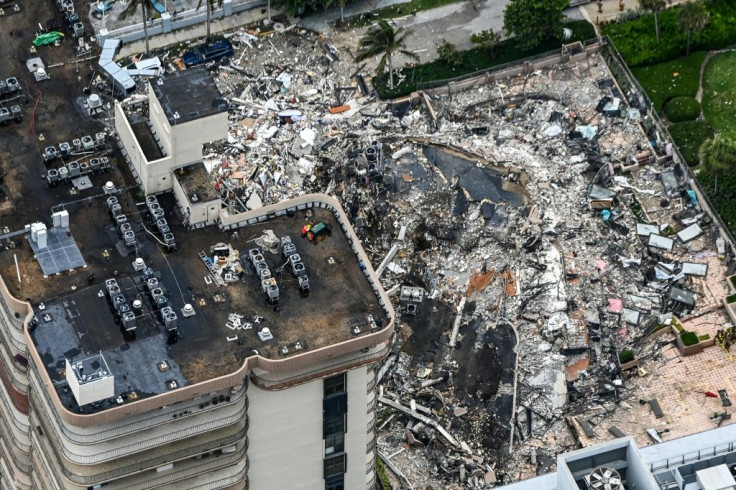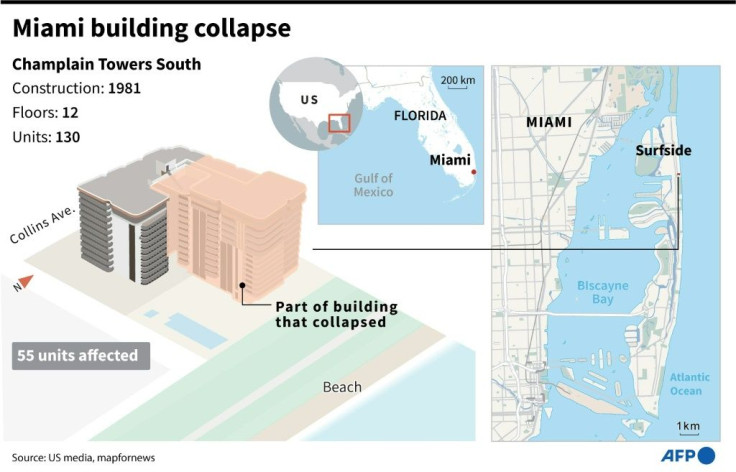Demands For Answers In Aftermath Of Florida Building Collapse
Rescuers are still searching for survivors in rubble of the collapsed Florida apartment tower, but pressure is building -- from families of missing residents to the state's governor -- for answers on how such a disaster could have occurred.
A wing of the oceanfront complex suddenly pancaked on itself around 1:30 am (05:30 GMT) Thursday, with 55 apartments collapsing in a cloud of dust, leaving 159 people still missing on Friday.
Completed in 1981, Champlain Towers South was due to be recertified this year in line with Miami-Dade county safety regulations -- which require a review every 40 years -- and roof work was ongoing as part of that process.
But county officials stressed there was no indication of a causal link between the refurbishment work and the collapse, which so far has a confirmed death toll of four.
In addition to the loved ones of the dead and missing, and those who are suddenly homeless, "there's a lot of other people throughout this community and really throughout Florida who want to know, well, how could a building just collapse like that?" Governor Ron DeSantis said.
He called for a "timely" explanation, adding that families "have a right to know."
Mike Salberg, who is waiting for information on five missing family members, including his parents, echoed the sentiments.
"I want answers," the New Yorker told AFP. "The families are sidelined."

Attention has turned, however, to a study led by Florida International University's Shimon Wdowinski, based on space-based radar data, which found signs of land subsidence at the site between 1993 and 1999.
"I don't know if the collapse was predictable. But we did detect that the building moved in the 1990s," the environment professor said on CNN.
"It's very subtle. It's two millimeters per year but it's still detected by the satellites," he explained, describing what was happening as a "slow process" of settling, rather than sinking.
"In this case, it's a very localized signal of that building," he said.
"And it means that it's not necessarily the building moved into the ground. It can be that the building moved within itself -- if there were some kind of structural damage within the building."

FIU cautioned in a post on its website that "land subsidence in and of itself likely would not cause a building's collapse."
The university also noted that the subsidence observed in Surfside was significantly slower than other parts of the planet Wdowinski has studied -- Mexico City, for example, is subsiding at a rate of 15 inches per year, 2,000 times higher.
Another of the university's experts, Atorod Azizinamini, chair of its civil and environmental engineering department, cautioned in an online video that it was too soon to speculate on a cause.
He said structural engineers would collect vast quantities of data on the building's design plans and construction methods, take samples of steel and concrete, look at signs of corrosion, examine the foundation for signs of settlement, and try to detect any unusual event before the collapse.
"Once we have all the information we can simulate exactly different scenarios, and we can pinpoint how the collapse took place," Azizinamini said. "Unfortunately that is not going to be happening in a matter of days, weeks."
"It's going to take some time."
But Matthys Levy, a consulting engineer and professor at Columbia University interviewed by USA Today, said even the minor subsidence detected could have an impact.
"A millimeter may seem like a small number, but when you add them up over many years, it becomes a big number," Levy said -- who pointed to the fact that one part of the building is still standing as potentially significant.
If one part of a building is well-founded and the other is not, he explained, it can cause distortion in the floor slabs and "suddenly, you get cracking, breaking and fracturing."
That can lead to what is called progressive collapse -- as happened during the September 11, 2001 attacks in New York.
"If one part of the building fails, it drags the rest with it," Levy said. "There's nothing there to stop it, there's no strong elements to hold it back. It's a cascade."
US media have separately reported that a 2015 lawsuit from an owner alleged that the building's management failed to maintain an outside wall, resulting in water damage and cracks.
vgr-ec-acb/dw
mex
© Copyright AFP 2024. All rights reserved.





















